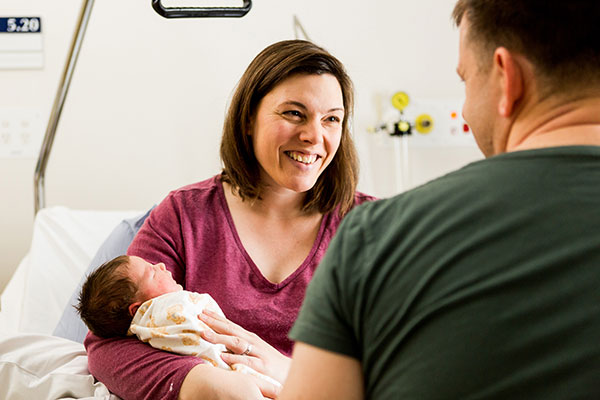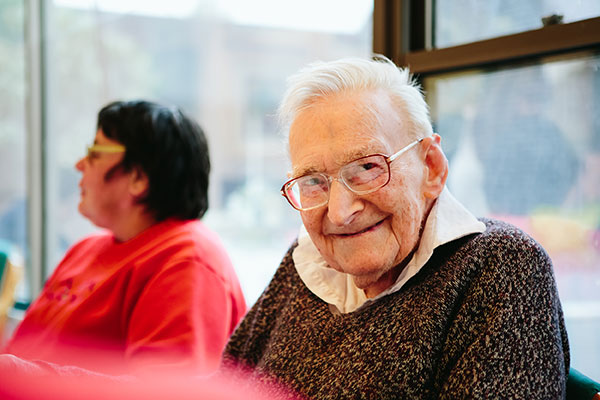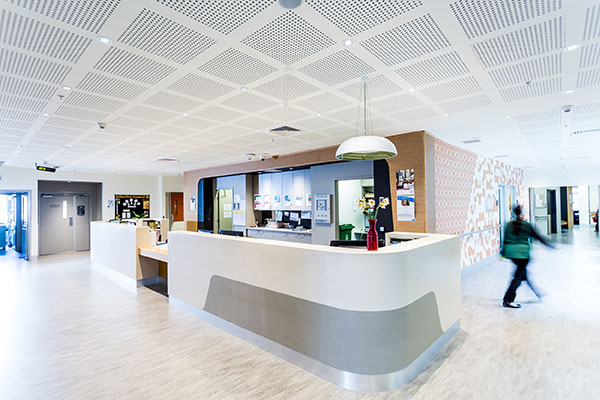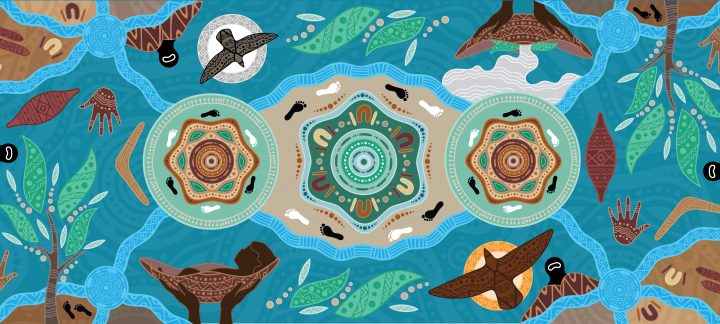Mercy Health is proud to launch our reconciliation artwork, wahbung-ngetel (‘call of country’), by Yorta Yorta and Gunnai artist Dixon Patten. The artwork tells our reconciliation story in images, honouring the Mercy heritage story alongside the 60,000-year history and heritage of the First Peoples of Australia.
Dixon Patten shared his story with Mercy Health on the banks of Lake Tyers at Bung Yarnda, the former Aboriginal Mission just outside of Lakes Entrance. His family has lived in the Gippsland Lakes region for generations, before and after Europeans arrived and declared the country Terra Nullius. His family’s story, like that of many Aboriginal and Torres Strait Islander people, is streaked through with trauma, loss and dispossession. Writing a new, more hopeful chapter is part of what drives Dixon Patten in his life and his work.

Yorta Yorta and Gunnai Artist Dixon Patten
Sitting by the Snowy River in Orbost, we chat with Dixon’s grandmother Lina, who was born on the banks of the river at a time when Aboriginal babies were not allowed to be born in hospital. Dixon’s mother Carol is also there, setting foot on Country for the first time in over a decade. Carol is part of the Stolen Generation; she was taken from her mother when she was just four years old and reunited with her in difficult circumstances. The trio welcomed Mercy Health to join them on Country, but the interview is more than that: it is an opportunity for healing.
When Mercy Health contacted Dixon in 2019 to design an artwork to reinterpret the Mercy Health story, we wanted to reconcile our own Mercy and Catholic heritage with the much older stories of culture and country told by our First Peoples — Aboriginal and Torres Strait Islander peoples. The artwork will also adorn and support our new Health Services Reconciliation Action Plan. There have been many meeting points between Mercy Health in Dixon’s life and family: he was born at the former Mercy Maternity Hospital in East Melbourne in the same week as two of his cousins and he was present for the birth of his two nieces at the current Heidelberg site.
After his niece’s birth, Dixon’s mother asked the hospital if she could take the placenta back to Gippsland to bury beneath a tree along the Snowy River. Birthing trees were once a common cultural practice for some mobs: the child’s father would choose the tree and it would remain sacred to that person until their death. To the family’s surprise and joy, Mercy Health agreed. It was the first of many such cultural observances that Mercy Health has supported and honoured since then — and it remains deeply important to Dixon and his family.

Dixon’s mother Carol, who is part of the Stolen Generation
Having been raised by his mother and grandmother, Dixon was also drawn to the Mercy story because of our history of strong female leaders. In the centre of Dixon’s artwork there is a gathering: the ‘U’ shape depicts people sitting together to talk, teach and learn. To Dixon, this represents a long line of influential women, from the Founder of the Sisters of Mercy, Catherine McAuley, to the Sisters who landed in Swan River, Western Australia, in 1857 to establish schools, and the Sisters who later travelled to Melbourne where, in 1920, they opened St Benedict’s Hospital in Malvern, marking the start of the Mercy Health journey. “It is about paying homage to and honouring strong women,” Dixon says.
Also featured in his artwork are the Wurundjeri creator beings Bunjil and Waa, a wedge-tailed eagle and crow. For Dixon, Bunjil holds special significance as his personal totem. When he sees Bunjil, he knows he is on the right path. Later that morning, while Dixon is sitting by the lake talking to Mercy Health, he halts mid-sentence. “Bunjil,” he says, and then turns his head. A wedge-tailed eagle soars above the trees in the distance — keeping watch.

Mercy Health’s reconciliation artwork, wahbung-ngetel (‘call of country’), by Yorta Yorta and Gunnai artist Dixon Patten
Every symbol in the artwork, including the water, the coolamon and the ancestors in their possum-skin cloaks, serves to connect 60,000 years of Aboriginal history and heritage with Mercy Health’s own busy century. Dixon is positive about Mercy Health’s reconciliation journey and says the first step for anyone engaging with his artwork is curiosity: “Aboriginal history is Australian history. I hope that [my artwork] encourages conversation; that it inspires people and makes them want to know more. Things get better through education. I hope it makes people curious about Aboriginal culture — and themselves.”
“Dixon’s original artwork will feature in our Health Services’ second Reconciliation Action Plan (RAP), Innovate, which builds on the work we have done in our Reflect RAP,” says Chief Executive Health Services Jason Payne.
Aboriginal history is Australian history. I hope that [my artwork] encourages conversation; that it inspires people and makes them want to know more.
“It is a creative and innovative way of describing our reconciliation story and our commitment to honouring the voice and heritage of Aboriginal and Torres Strait Islander Peoples.” Mercy Health Group Chief Executive Officer Adjunct Professor Stephen Cornelissen says the organisation recognises the moral responsibility and opportunity to forge meaningful and purposeful reconciliation with our First Peoples.
“Mercy Health is committed to walking together with Aboriginal and Torres Strait Islander Peoples, in respect and solidarity, as we progress our reconciliation journey,” he says. “In this iteration of our Health Services RAP we challenge ourselves to make real and lasting change.”



